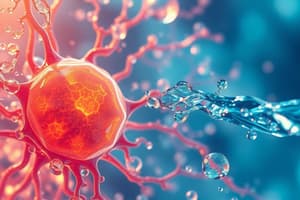Podcast
Questions and Answers
Which of the following elements is NOT directly involved in the structural integrity of nucleic acids (DNA and RNA)?
Which of the following elements is NOT directly involved in the structural integrity of nucleic acids (DNA and RNA)?
Which element is crucial for the creation of complex organic molecules due to its ability to form multiple covalent bonds?
Which element is crucial for the creation of complex organic molecules due to its ability to form multiple covalent bonds?
What is the primary role of Potassium (K), Sodium (Na), and Chlorine (Cl) in cells?
What is the primary role of Potassium (K), Sodium (Na), and Chlorine (Cl) in cells?
Which element is a component of vitamin B12 (cobamide)?
Which element is a component of vitamin B12 (cobamide)?
Signup and view all the answers
Which of the following elements is NOT a component of amino acids?
Which of the following elements is NOT a component of amino acids?
Signup and view all the answers
Which functional group is NOT directly associated with Oxygen (O)?
Which functional group is NOT directly associated with Oxygen (O)?
Signup and view all the answers
Which of the following elements is NOT involved in energy transfer within cells?
Which of the following elements is NOT involved in energy transfer within cells?
Signup and view all the answers
Which characteristic of water is NOT related to its polarity?
Which characteristic of water is NOT related to its polarity?
Signup and view all the answers
Flashcards
Fundamental unit of life
Fundamental unit of life
Cells are the basic structural and functional units in all living organisms.
Four abundant elements
Four abundant elements
Carbon, hydrogen, oxygen, and nitrogen are the four most abundant elements in living organisms.
Role of Carbon
Role of Carbon
Carbon forms the backbone of most organic molecules and enables complex structures.
Water's importance
Water's importance
Signup and view all the flashcards
Nitrogen's function
Nitrogen's function
Signup and view all the flashcards
Trace elements
Trace elements
Signup and view all the flashcards
Phosphorus role
Phosphorus role
Signup and view all the flashcards
Essential ions
Essential ions
Signup and view all the flashcards
Study Notes
Introduction
- Cells are the fundamental units of life, composed of various elements.
- The elemental composition of cells is highly specific, reflecting the essential roles of each element in biological processes.
- The four most abundant elements in living organisms are carbon (C), hydrogen (H), oxygen (O), and nitrogen (N).
Major Elements
-
Carbon (C): Forms the backbone of most organic molecules.
- Crucial for building carbohydrates, lipids, proteins, and nucleic acids.
- Carbon's ability to form multiple covalent bonds allows for the creation of complex structures.
-
Hydrogen (H): Abundant in water and organic molecules.
- Plays a role in many biochemical reactions.
- Important constituent of functional groups like hydroxyl (-OH).
-
Oxygen (O): Essential for respiration and other metabolic processes.
- Component of water, vital for cellular function.
- Forms important functional groups like carbonyl (-CO) and carboxyl (-COOH).
-
Nitrogen (N): Key component of proteins and nucleic acids.
- Found in amino acids and nitrogenous bases.
- Critical for the structure and function of biological molecules.
Other Important Elements
-
Phosphorus (P): Major component of nucleic acids (DNA and RNA).
- Important for energy transfer (ATP).
- Contributes to structural components like phospholipids.
-
Sulfur (S): Component of some amino acids (cysteine, methionine).
- Involved in protein folding and structure.
- Participates in enzymatic activities.
-
Calcium (Ca): Primarily involved in structural support and signaling.
- Forms bones and teeth.
- Important for nerve impulse transmission.
-
Potassium (K), Sodium (Na), and Chlorine (Cl): Essential for maintaining osmotic balance and nerve impulse transmission.
- Involved in the regulation of water and ion concentration.
- Crucial for maintaining cellular function.
Trace Elements
- Trace elements are essential, but in minute quantities.
- Iron (Fe): Crucial for oxygen transport (hemoglobin).
- Zinc (Zn): Essential for enzyme function.
- Copper (Cu): Important in various metabolic processes.
- Manganese (Mn): Involved in enzyme activation.
- Cobalt (Co): Component of vitamin B12 (cobamide).
- Required for various enzymatic processes and cellular functions.
- Their deficiency can lead to significant health problems.
Water
- Water (H₂O) is the most abundant molecule in cells.
- Its properties, such as polarity, are crucial for life.
- Excellent solvent for many biological molecules.
- Plays a role in temperature regulation.
- Important in chemical reactions.
- Crucial for transport and other essential cell functions.
Organic Molecules
- Organic molecules (compounds containing carbon) are essential components of cells.
- Carbohydrates, lipids, proteins, and nucleic acids are organic molecules.
- They are primarily composed of C, H, O, N, and sometimes P, S.
Summary
- The elemental composition of cells is not random.
- Specific elements are crucial for forming biological molecules essential for life.
- Careful control of element concentrations is essential for healthy cellular function and survival.
- Trace elements, though required in tiny amounts, are equally vital.
- Understanding the elemental composition of cells is fundamental to comprehending their structure and functions.
Studying That Suits You
Use AI to generate personalized quizzes and flashcards to suit your learning preferences.
Description
Explore the fundamental elements that make up cells in this quiz. Discover the roles of carbon, hydrogen, oxygen, and nitrogen in biological processes. Test your knowledge on how these elements contribute to the structure and function of living organisms.




